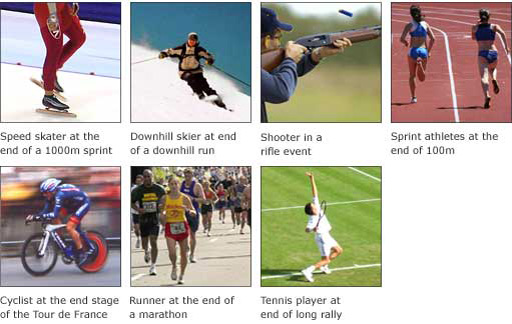4.4 Maximum heart rate
The other part of an efficient heart is the maximum rate that it can beat. If we think about competitors in a race that takes about five minutes, the athlete whose heart can beat at 200 times per minute for five minutes will probably do much better than one whose heart can only beat at 180 times per minute.
This is linked to how much blood is pumped with each beat. If an individual's heart doesn't pump very much blood when they are resting, then the heart rate has to increase so much during exercise that it cannot be sustained for a long time. A heart that pumps a lot of blood per pump already when resting doesn't have to increase the rate as much during exercise. Hence it can keep going for long periods while still pumping lots of blood. For athletes in almost any sport, an efficient heart is an advantage.
Athletes also train so that the arteries actually become larger, allowing greater blood flow around the body. Larger arteries also mean that the heart doesn't have to pump as hard to send the same volume of blood around the body.

Activity 5: Athletes and heart rates: What you need to do
Think about the athletes in these photographs, and the sport involved. In which sport does the heart beat the fastest? In which one does the heart beat the slowest? Rank the athletes in these sports according to heart rate, from highest to lowest.
Discussion
| Activity | Heart rate |
|---|---|
| Speed skater | 1 – Highest |
| Downhill skier | 2 |
| Cyclist | 3 |
| Distance runner | 4 |
| Sprint athelete | 5 |
| Tennis player | 6 |
| Shooter | 7 – Lowest |
How did you do? Were any of these answers a surprise?
The order of the athletes is largely influenced by the length of the race, with the exception of the shooter as we'll see. In a very short race, like the 100 m sprint, the heart does not really get a chance to reach its maximum rate. At the end of a long exhausting race, like a long-distance cycling event or a marathon, the heart is beating as fast as it can but the body is so tired that it is not beating at its maximum rate.
So the athlete with the highest heart rate is probably the speed skater, because the distance is long enough for the heart to reach its most efficient state, but not so long that fatigue becomes important. I have said ‘probably’ because there are many variables including the differences between athletes' bodies.
Although travelling very fast, a downhill skier doesn't seem to use lots of energy. Skiers, though, have to control their bodies and this does require effort – a great deal of effort at the frenetic pace of a downhill run. This means their hearts will be driving blood to all parts of their bodies.
The distance runner and the distance cyclist probably have similar heart rates – high but fatigued. They probably put a lot of effort into the last few moments of the race, and that too affects the heart rate.
The tennis player is harder to judge. He has to use short explosive bursts of energy, and so has to act like a sprinter for fractions of seconds. However, he has to keep doing this for long periods of time, and so his heart cannot go at the rate of a 100 m sprinter, because that is not sustainable. He would not be able to start the next point if his heart was working the same as the sprinter.
The last athlete on the list, the shooter, is completely different from the others because she will have a heart-rate lower than normal. For steadiness and reliability, shooters train to slow their heart rates down in a controlled way. In fact, these athletes train so that they fire the gun in between heart beats, which gives the maximum stability.
Before you move on there have been a number of ideas we hope you have picked up in this section.
Activity 6: What you need to do
Create a list of what you think are the most important points in this section. This could be a bulleted list so doesn't have to be sentences; you should only have one idea in each bullet point.
Discussion
Compare your list to the one here. They are likely to be different as we each have our own way of recording what's important to us but some of the main points should be the same. If you've missed off some points add them to your notes before you go on.
- An efficient heart can pump a lot of blood with each pump and can beat quickly for a long time.
- Athletes train to have efficient hearts (that pump more blood with each pump, and can beat quickly for long time) to get oxygen and nutrients to all their bodies more quickly.
- Resting heart rate equals the number of beats per minute when someone is resting.
- A non-athlete's resting heart rate usually equals 55–65 beats per min.
- An athlete's resting heart usually equals 40 beats per min (can be 30!).
You can measure your heart rate by feeling your pulse at your wrist or neck.
A few final thoughts
Given what we have learnt so far the body clearly needs to be able to absorb oxygen as efficiently as possible. This means that part of being a successful athlete means having healthy lungs. This is the subject of Section 6.
